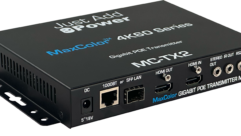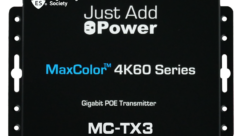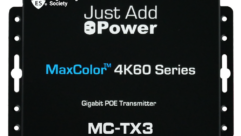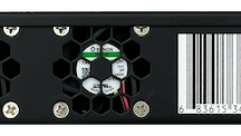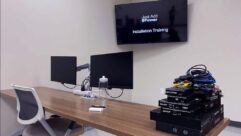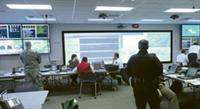

Just in Time: A Rocky Mountain Makeover
Doug Hardman had a lot of work to do to bring the AV system in the Ada City-County Emergency Management Center (ACCEM) in Boise, Idaho, into the 21st century.
Doug Hardman had a lot of work to do to bring the AV system in the Ada City-County Emergency Management Center (ACCEM) in Boise, Idaho, into the 21st century. The center, housed in a concrete building, had two projectors and some chalkboards. The low-tech setup didn’t do justice to its importance in the earthquake-prone area.
CHALLENGE: Dramatically upgrade a community’s emergency management center with federal grant money to integrate disparate video feeds.
SOLUTION: Build the solution around economical Cat-5 wiring, but employ robust distribution systems to ensure critical information gets to the right place–whether it’s a long or short run.
Creating an emergency management center that could handle the ad hoc video needs of outside agencies was important.
Credit: Courtesy Compview
Last summer and fall, ACCEM used Homeland Security grants to scope out a new system and procure the necessary components, setting a Christmas deadline to overhaul its AV operations. A three-person crew from integrator CompView worked through the holidays and, through no fault of its own, just missed the deadline. But, it was the result that counted.
Because no sooner did the new hardware come online in January than Hardman, the center’s director, faced a major test: the Special Olympics Winter Games, scheduled for mid-February. With a host of dignitaries expected to be in attendance, the Department of Defense and Secret Service placed their own demands on the spanking-new command-and-control center.
“We had very little time to learn on it ourselves and to use the system before the Special Olympics was here,” Hardman says.
At the heart of the operations center was a video distribution backbone that had to be efficient and reliable. This wasn’t just any video, audio, and data the center was handling. It was critical information for running a safe Special Olympics, and it needed get to the people and agencies who could act on it–every time.
Wiring It In
The design relies on low-cost wiring that saves money yet still meets quality requirements and even improves reliability.
“It uses standard Cat-5 cable to bring all the information back to the system,” says Jeffrey Kaylor, systems integration manager and senior design engineer at CompView in Garden Grove, Calif. “This lowers the cost of the installation and provides more robustness because the cable can stand lots of abuse.”
Using Cat-5 instead of dedicated AV cabling such as coax also makes upgrades easier. “All you’ve got to do is bring an IT guy in there and hook up an RJ45 cable,” Kaylor says.
The ACCEM distribution system is able to patch in video from Boise’s 70 traffic and downtown security cameras.
CompView pulled new wire for the center, but has been able to use some existing Cat-5 to link up with police dispatch elsewhere in the building. Kaylor used a Belden cable that is engineered to AV specs up to 1,000 feet, which means it achieves its claimed twists per inch and has no imperfections, such as kinks, that can distort the cable length and cause skew.
“When you’re in the digital world, that cable can’t be off by more than a quarter of an inch,” Kaylor says.
Although dedicated cable-equalization devices are available to address skew, Kaylor says he didn’t need them. The 24 AMX (formerly AutoPatch) CatPro transmitters and receivers used have skew compensation built in. “We set all the boxes for up to 1,000 feet,” he says.
The distribution nerve center is an AMX AutoPatch multiformat matrix router fitted with a variety of add-ons. “It’s a modular chassis that you populate with cards for whatever the requirements are,” Kaylor says, adding that CompView pre-built the rack in California. “We’re able to do a lot in a small space.”
An AMX Octaire 64×48 video router takes in the output from freeway and IP cameras. Modula 24×32 Analog RGBHV and 24×12 Stereo Audio switchers handle video and audio I/O. No special cabling was needed to connect content sources to the rack. Kaylor says
ACCEM specified a requirement of high definition resolution, so all equipment supports HD, most at 1080p.
Kaylor raves about the Analog Way three-input scaler he used to scale video to the various size displays. “It’s one of the premier products out there that is true WYSIWYG,” he says. “Even as it downscales, it still maintains the same image quality without loss.”
Also new is a Polycom VSX 8000 videoconferencing system. Four television tuners provide commercial cable and satellite feeds, plus there’s a Denon DN-V300 DVD player.
Not Just Hang-and-Bang
The visual centerpiece is a 2×2 array of four, 52-inch NEC LCD panels. Hardman says ACCEM likes the arrangement because it allows four separate feeds or a single large one. “We wanted the biggest displays we could get, but when we found out some prices, we started scaling back,” he says.
CompView faced quite a challenge mounting the NEC monitor array. Kaylor blames the building’s poured-in-place concrete. “The surfaces weren’t straight, and the way concrete tends to cure, the wall was in waves,” he says.
Equipment List
Below is a partial list of the equipment installed by CompView for the Ada City-County Emergency Management Center.
- AMX Octaire 64×48 video router
- AMX Modula 24×32 Analog RGBHV switcher
- AMX Modula 24×12 Stereo Audio
- 24 AMX CatPro transmitters, receivers
- Analog Way three-input scaler
- Crestron 10.4-inch TPS4000LB touch panel
- Crestron 8.4-inch TPMC-8X wireless touch panel
- 4 52-inch NEC LCD flat-panel displays
- 2 Projectiondesign 1080p DLP projectors
- Polycom VSX 8000 videoconferencing system
The monitors had to be perfectly squared, a job made trickier because they were connected to each other, so CompView brought in laser guides to make sure. Equipment also had to be able to withstand earthquakes, a requirement Kaylor knows well from his California customers.
The single-feed view has a crosshairs effect that makes it unsuitable for training videos. For that, Hardman uses two Projectiondesign 1080p DLP projectors and a 19.5-foot screen, which can each display up to four windowed PC or video sources. The projectors often display WebEOC, blog-like software popular with emergency-management centers that lets people enter updates in real time. “From anywhere in the room, people can look up and read that,” Hardman says.
An operator can switch any content source to any display from a 10.4-inch Crestron TPS4000LB touch panel mounted on the podium or an 8.4-inch Crestron TPMC-8X wireless panel in the equipment rack. CompView was able to reprogram both remotely to accept temporary feeds from DoD’s security cameras, displaying up to eight per monitor. Hardman says officials were able to follow Vice President Joe Biden’s motorcade continuously through the streets of Boise, thanks to 70 traffic cameras and downtown security cameras.
The room has no fixed furniture so it can accommodate the ad-hoc mix of agencies that typically respond to an event. The system’s flexibility quickly proved its value when DoD brought in its own PCs, and Hardman had 25 VoIP telephones installed, all linking to six data ports, each alongside a power cord, coming down from the ceiling. DoD also brought in four monitors that were connected to the signaling equipment via 75-foot VGA cables, according to Hardman.
Expecting the Unexpected
Kaylor says the federal authorities’ last-minute demands could have been a challenge without the flexible, modular infrastructure. “Signal distribution is something that is so radically overlooked,” he says, adding that he sometimes sees other installations and thinks, “someone wasn’t thinking of the future.”
Ultimately, Kaylor says the key was spending up-front time to capture everyone’s requirements, then designing a system that could accommodate the unexpected. “Do what they’re asking for, plus a little bit more,” he says.
Boise officials are happy with the results. “Having the ability to pull up any PC or video we need is pretty astonishing to our folks,” Hardman says. “We’ve never had that.”
David Essex is a freelance technology writer based in Peterborough, N.H.


